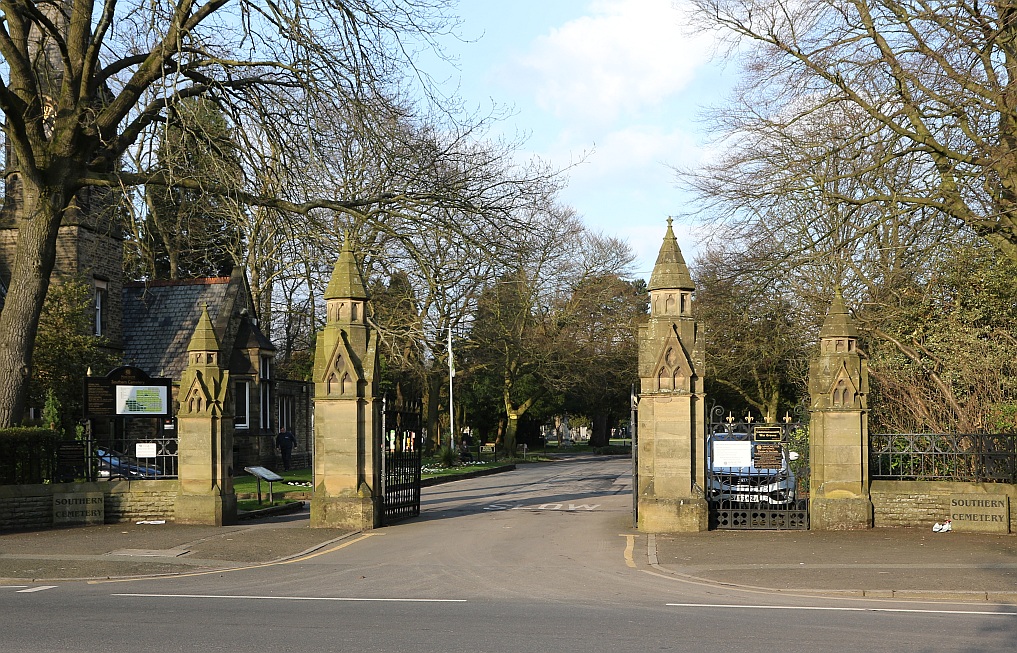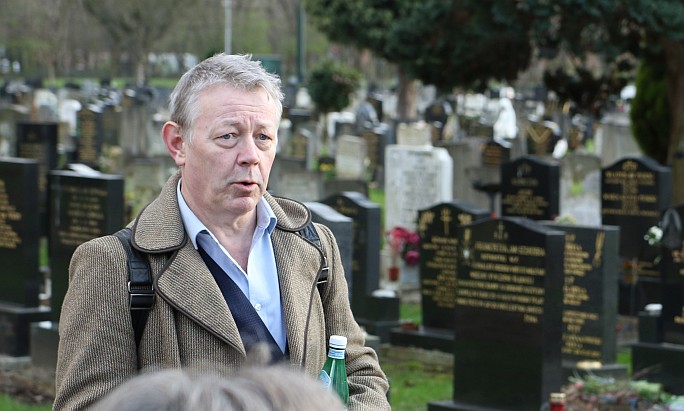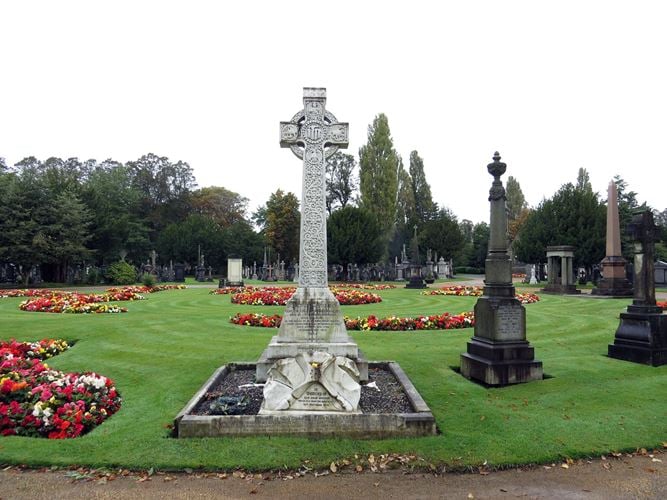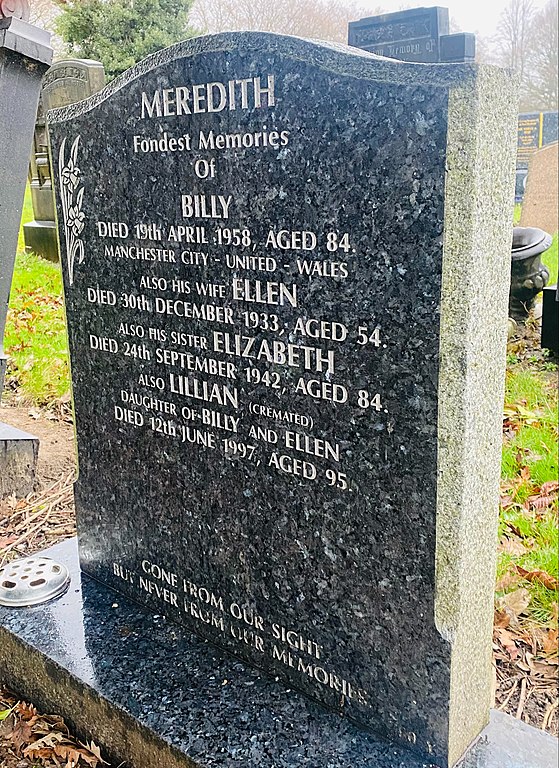This was the 102nd visit organised for MLHS by the indefatigable Judith Wilshaw, who was even able to organise dry sunny weather for our 20-strong group.

The Gates to Southern Cemetery
This cemetery is the largest in the country and reputed to be the second largest in Europe. The site was established in 1872 when Manchester Corporation bought 100 acres of land for £38,340. Our guide, Jonathan Schofield, pointed out that at that time the water table was at a depth of only 3 feet which made it a little problematic for 6 feet deep graves! A further 90 acres were added in 1926 and opened in 1943. The cemetery buildings (now listed) included three service chapels for Anglicans, Nonconformists and Roman Catholics designed by architect H J Paull but only one of these is still used, the others being semi-derelict. There is also a Jewish chapel to the west of the site and Muslim area to the east. The cemetery layout is attributed to City Surveyor James Gascoyne Lynde, and a few days after its consecration by the Bishop of Manchester, it was formally opened on 9 October 1879 by the Mayor of Manchester Charles Grundy.
Jonathan told us that the main gates by which we had entered the cemetery are “world famous” because coachloads of fans of The Smiths (a 1980s Manchester pop group) from as far away as Japan come to be photographed next to them as one of the group’s hits “Meet you at the Cemetery Gates” refers to these very gates.

Jonathan Schofield
For the next couple of hours Jonathan guided us on a tour of the cemetery. We were surprised by the large number of impressive gravestones and memorials which were indicative of prosperous families. He showed us 13 of them which were the final resting places of people who had led fascinating and important lives and with varied origins highlighting the multicultural origins of Manchester’s inhabitants.
The Rylands memorial is the grandest, although part of it was removed in1927 and its bronze railings were stolen in 1967. John Rylands (1801-88) was an entrepreneur, engineer and generous philanthropist and the first Manchester muti-millionaire. His company at its peak employed 15,000 people in its 17 mills and factories. When he died his estate was worth £305M (as of 2024 values) most of which he left to his young third wife Enriquetta (1843-1908) who founded the John Rylands Library in memory of John. She is also commemorated on the Rylands memorial, her ashes being in its vault.
We moved on to Major Howard Redmayne Harker MC RAF who was a flying ace and aerial photography pioneer in the Great War (1891-1919). He was awarded the Military Cross in 1917 for conspicuous gallantry and skilled leadership in aerial battles. He survived the war only to be defeated by the Spanish Flu epidemic in 1919 when he was only 27.
Then we came to an Armenian area of the cemetery where Jonathan showed us the grave of the celebrated violinist Olive Zorian (1916-1965). Her father Samuel had been imprisoned as a political activist in Turkey before relocating to Manchester and becoming a prominent cotton merchant.
Nearby was buried Tony Wilson (1950-2007) well known for his BBC documentaries, his role as a cultural catalyst and encouragement of music group regionalism, setting up the Hacienda night-club and Factory Records. Jonathan said he at times broadcast with him.

Alcock Monument
Then came another flying pioneer Sir John W. Alcock who, with Sir Arthur Brown as navigator, made the first non-stop transatlantic flight 14-15 June 1919 for which they were knighted. We were surprised the monument did not mention Brown.
L S Lowry (1887-1976) is buried with his parents in a modest grave with an inconspicuous very brief epitaph to him on the side of the grave which Jonathan had to point out to us. It simply says “Also their beloved son Laurence Stephen Lowry” with his dates of birth and death. As he told Harold Wilson when he turned down a knighthood “All my life I have felt most strongly against social distinction of any kind.” He may have had a humble epitaph, but he does now have the £106M Lowry Art Gallery named after him, and of course his statue in Mottram in Longdendale which most of us will have seen.
Jonathan introduced us to Jerome Caminada (1844-1914) who served with the Manchester Police 1868-1899. He became the City’s first CID superintendent and pioneered the solving of crimes by deducing the facts from the evidence and is thought to have inspired Arthur Conan Doyle’s invention of Sherlock Holmes.
Having already introduced us to the Armenian area of the cemetery, Jonathan brought us to the Polish area and showed us the grave of celebrated poet Maria Jasnorzewska (1891-1945). She came from a noted artistic family in Poland and managed to get to England at the outbreak of war in 1939. She sadly died of cancer. It takes only moments of Google to find her many poems and her life story. Google instantly translates to English. Luckily one of our group was fluent in Polish and could pronounce her name properly and translate the inscriptions on her monument.
 Group by the monument dedicated to Daniel Adamson
Group by the monument dedicated to Daniel Adamson
We saw the impressive funerary monument of Daniel Adamson (1820-1890), an engineer who became a successful manufacturer of boilers. He became the driving force behind the construction of the Manchester Ship Canal but sadly died before it was completed on 7 December 1893. We also saw the monument to Charles Sacre, a successful railway engineer. The poor chap shot himself in 1889 as he never got over feeling guilty for the 1884 Penistone rail crash when19 people died, including one of his close friends, a railway company superintendent. No-one blamed him but himself as he had given in to pressure to adopt a certain braking system.
 Finally, a word about the three football celebrities whose graves we saw. Firstly, John Henry Davies (1864-1927) of Bramhall Hall who was a wealthy brewery owner whose wife Amy still sits (as a statue) on their monument grieving for him. In 1902 he financially rescued Newton Heath Football Club. He changed its name to Manchester United and it won the League in 1908 and the FA Cup in 1909. Davies then funded the move to a new ground at Old Trafford in 1910. Secondly, Welsh footballer Billy Meredith (1874-1958) one of the early superstars of football due mainly to his performances for both City (366 appearances, 148 goals) and United (303 appearances, 35 goals) and thirdly, none other than Sir Matt Busby (1909-1994) whose life and career we all remember. He and his family’s grave is marked by a tasteful but rather modest gravestone compared with some of the others we visited.
Finally, a word about the three football celebrities whose graves we saw. Firstly, John Henry Davies (1864-1927) of Bramhall Hall who was a wealthy brewery owner whose wife Amy still sits (as a statue) on their monument grieving for him. In 1902 he financially rescued Newton Heath Football Club. He changed its name to Manchester United and it won the League in 1908 and the FA Cup in 1909. Davies then funded the move to a new ground at Old Trafford in 1910. Secondly, Welsh footballer Billy Meredith (1874-1958) one of the early superstars of football due mainly to his performances for both City (366 appearances, 148 goals) and United (303 appearances, 35 goals) and thirdly, none other than Sir Matt Busby (1909-1994) whose life and career we all remember. He and his family’s grave is marked by a tasteful but rather modest gravestone compared with some of the others we visited.
Our group much enjoyed this visit to Manchester Southern Cemetery, so ably led by our favourite Blue Badge Guide, Jonathan Schofield, who has shown us quite a number of different aspects of Manchester over the years. His aim is always for a tour to be memorable and for people to feel excited, to have had a good time and a bit of a laugh. Once again he met his objectives.
Ralph Atherton, March 2024













